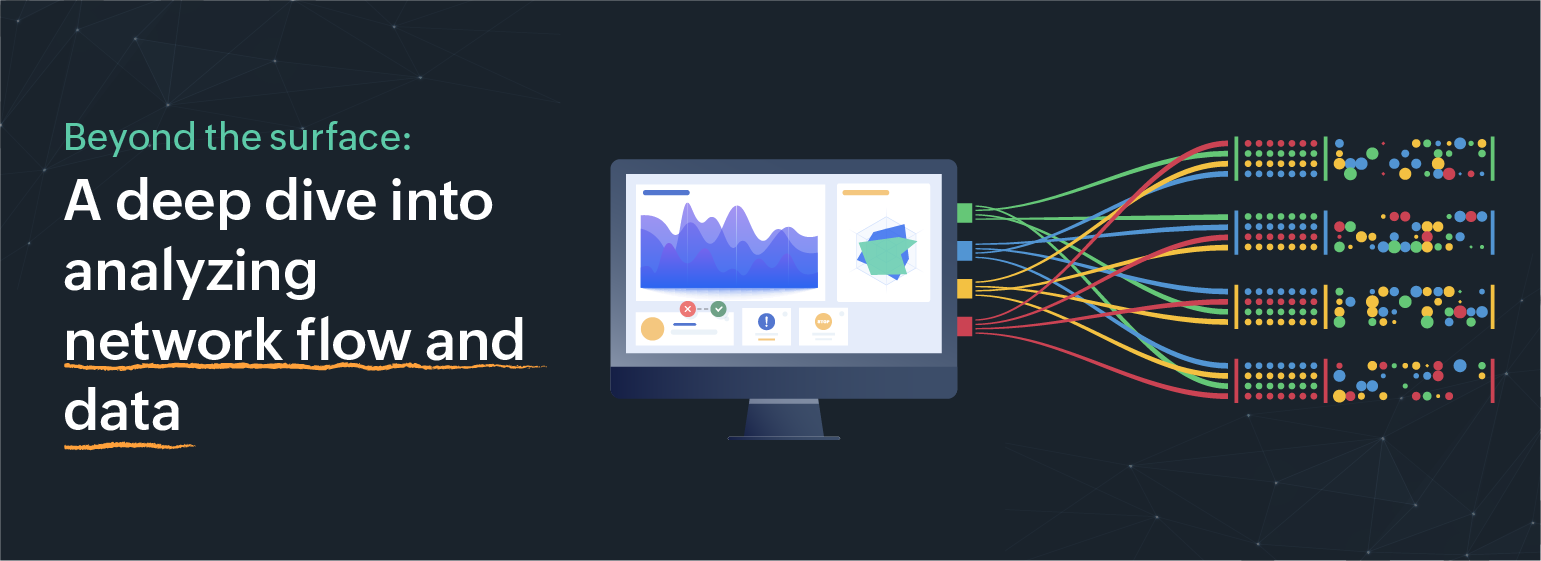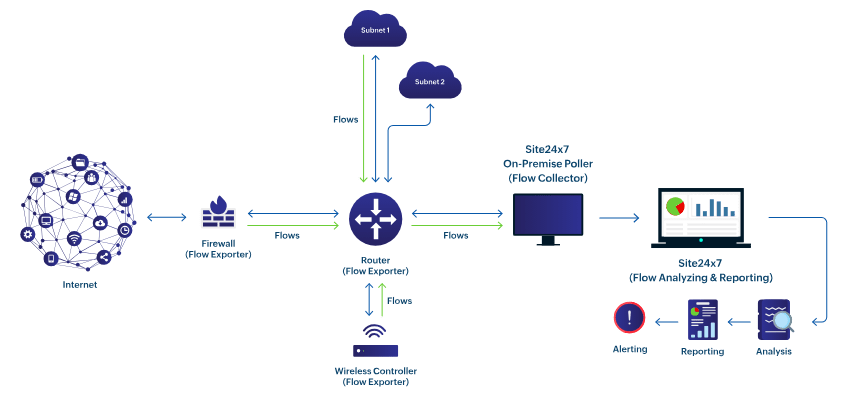From chaos to clarity: Using NetFlow analysis for efficient network management

Analyzing network traffic data can quickly descend into chaos due to the increasing number of devices and applications in organizations, making it difficult to untangle the complexity manually. Many organizations now use network traffic analyzers to streamline this process. But what exactly is a network traffic analyzer, and how can it help with effective network management? Let's explore this in detail.
Understanding network flow
When two or more devices communicate with each other, they create a pathway for sending and receiving information, which is known as a communication channel. Once this channel has been established, the devices can exchange data using a specific set of rules, also known as a protocol. The series of data packets that are sent through this communication channel using a single protocol is called a flow.
Most networking devices can collect important details about data flow, such as in and out traffic, the type of protocol used, and the IP addresses of the source and destination devices. This collected data is then exported to a tool for analysis. Cisco initially developed this protocol, calling it NetFlow; these days, each vendor has their own variation. For instance, Huawei's version is called NetStream, Juniper's is called J-Flow, Amazon's is called AppFlow, and sFlow is a multi-vendor offering. Based on the need for a more universal IP data export flow, the Internet Engineering Task Force created IPFIX, which has now become the industry standard. Network traffic monitoring tools like Site24x7 can support data collection for all these flow types.
Decoding NetFlow: How does it work?
As NetFlow is more commonly used, we will use it as an example to illustrate how flow data collection and analysis works.
If you're using a traffic analysis tool, you're probably familiar with the terms flow exports, flow collector, and flow analyzer. However, let's take a moment to define them.
- Flow exporter: A device (like a router, switch, or firewall) that can be configured to export flows to a flow collector.
- Flow collector: A machine that receives the exported flows.
- Flow analyzer: A tool that can collate the data received from flows and analyze it. A flow analyzer can display the information on a dashboard, help you visualize the data through graphs or download the details as reports, and send alerts if there are any abnormalities.
The following image shows how Site24x7's NetFlow analyzer works.

A router is depicted exporting flows in this example. It sends flow data to the Site24x7 On-Premise Poller, which acts as the flow collector. This data takes the stage on a user-friendly dashboard, where network administrators can gain deeper insights. But that's not all—in a click, this data morphs into comprehensive reports, ready for download. Should anything unusual pop up, crossing those critical thresholds, immediate alerts are sent to the network administrators, ensuring they're always in the loop and ready to act.
Digging into the details: What data can you see?
You can view data at different levels, like:
- Device: Flow count (number of exported flows at a point in time), overall traffic (data/second), volume (total data)
- Interface: Statuses, in and out traffic details, top N applications, source and destination IP addresses, and conversation-specific data
- Application: Top applications and protocols that are using the most bandwidth within the network, in and out traffic
- Conversation: Devices between which there is a higher amount of traffic flow and data at the conversation level, like source and destination IPs; application names; and traffic details
- Quality of Service (QoS): Traffic flowing through differentiated services code point (DSCP) templates (DSCP is a method to classify and manage network traffic, and to obtain QoS statistics)
What can you do with NetFlow data?
Now that you have everything you need, let's figure out the best way to put it to use! How can we make the most of all these important details? Let's take a look.
Imagine this scenario: A handful of employees in your network have dived into the world of multiplayer online gaming during work hours. But here's the actual problem—their digital adventures are hogging so much bandwidth that it's causing a significant slowdown across the network. This ripple effect is taking its toll, dragging down productivity as other employees grapple with the snail-paced internet.
A NetFlow analyzer can help you detect such issues by providing in-depth details into which conversation is consuming the most traffic and identifying the source and destination IP details of those devices. So, you can actually identify who is hogging your network and ensure that bandwidth is released for other employees.
On a graver note, say there's an external threat actor launching a DDoS attack. In case of threats like these, the speed and accuracy of identifying an attack becomes crucial. Here, a NetFlow analyzer will detect unusual traffic spikes so that you can take immediate steps to mitigate them.
This is just one example of how NetFlow can help. In general, NetFlow can also help with faster incident detection and improving security posture.
Site24x7: The best NetFlow analyzer for enterprises
Network traffic analysis tools, particularly those utilizing NetFlow technology, have become indispensable in managing the complexity of modern organizational networks. These tools, like Site24x7, provide a detailed and comprehensive view of network traffic, allowing administrators to monitor data flows; identify bandwidth hogs; and detect potential security threats with precision, efficiency, and clarity. By leveraging the capabilities of network traffic monitoring tools, you can not only ensure optimal network performance but also enhance your security posture, making it a vital component of modern network management strategies. Whether dealing with the challenges of unauthorized high-bandwidth activities or protecting their network against external threats, network bandwidth monitoring tools like Site24x7 equip network administrators with the insights needed to maintain a smooth, secure, and efficient network environment.
Comments (0)